BMP3004 World of Work: Motivation, Factors & Coping Strategies
VerifiedAdded on 2023/06/18
|8
|2058
|378
Report
AI Summary
This report delves into the multifaceted aspects of employee motivation, highlighting that financial compensation is not the sole driver for individuals in their professional lives. It emphasizes the significance of personal growth, skill development, and social connections fostered through work. The report elucidates the concept of motivation, drawing upon Maslow's Hierarchy of Needs to illustrate the various levels of human needs that influence motivation. It identifies key factors such as salary, promotion opportunities, and the work environment as motivators for employees. Furthermore, the report examines both positive experiences, like opportunities for skill development and modern performance management practices, and negative experiences, such as toxic work environments and workplace conflicts, that impact employee job satisfaction. Finally, it proposes strategies to mitigate negative factors and foster a more positive work environment, including employee recognition and engagement initiatives, suggesting a holistic approach to enhancing employee motivation and overall well-being.
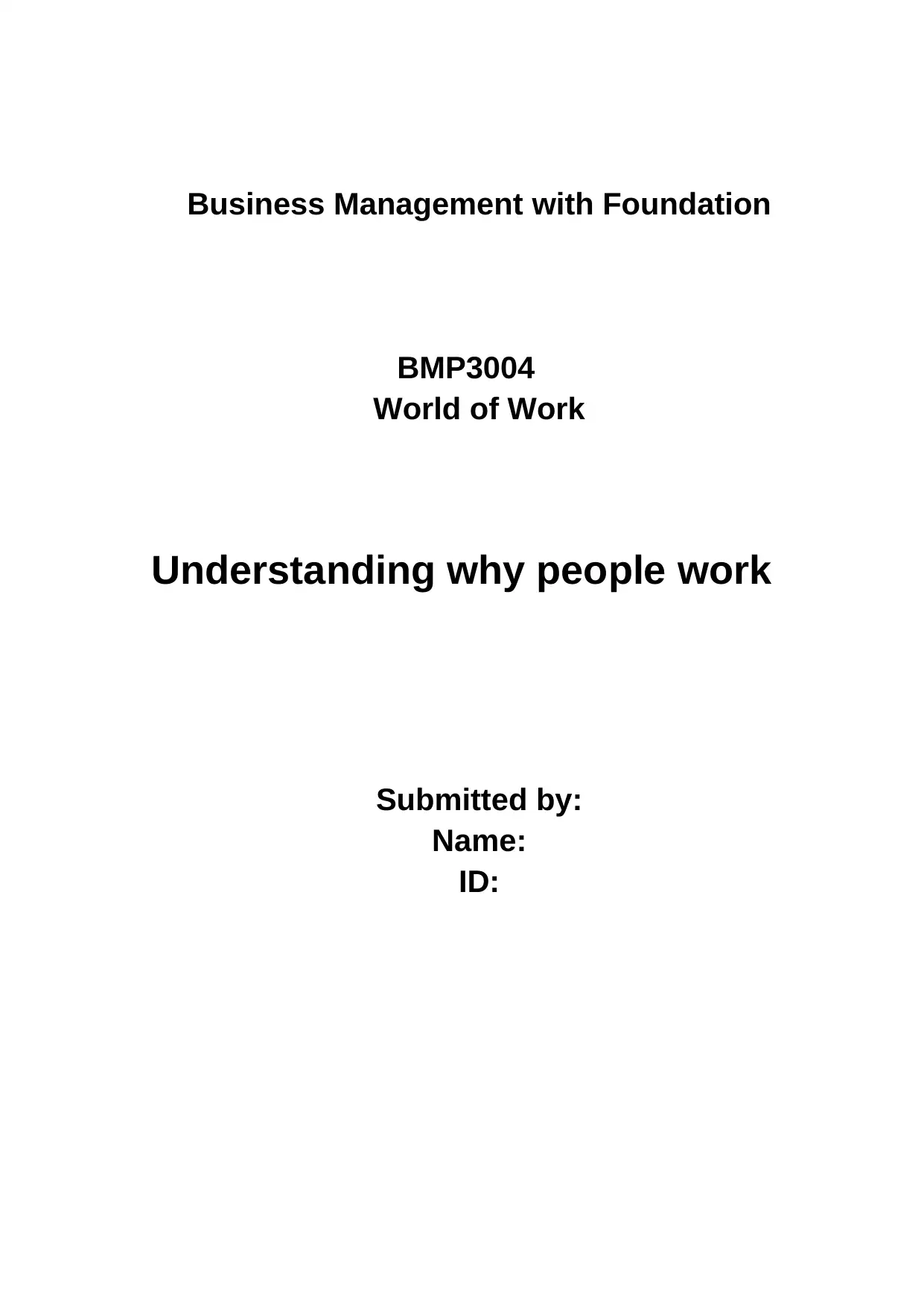
Business Management with Foundation
BMP3004
World of Work
Understanding why people work
Submitted by:
Name:
ID:
BMP3004
World of Work
Understanding why people work
Submitted by:
Name:
ID:
Paraphrase This Document
Need a fresh take? Get an instant paraphrase of this document with our AI Paraphraser
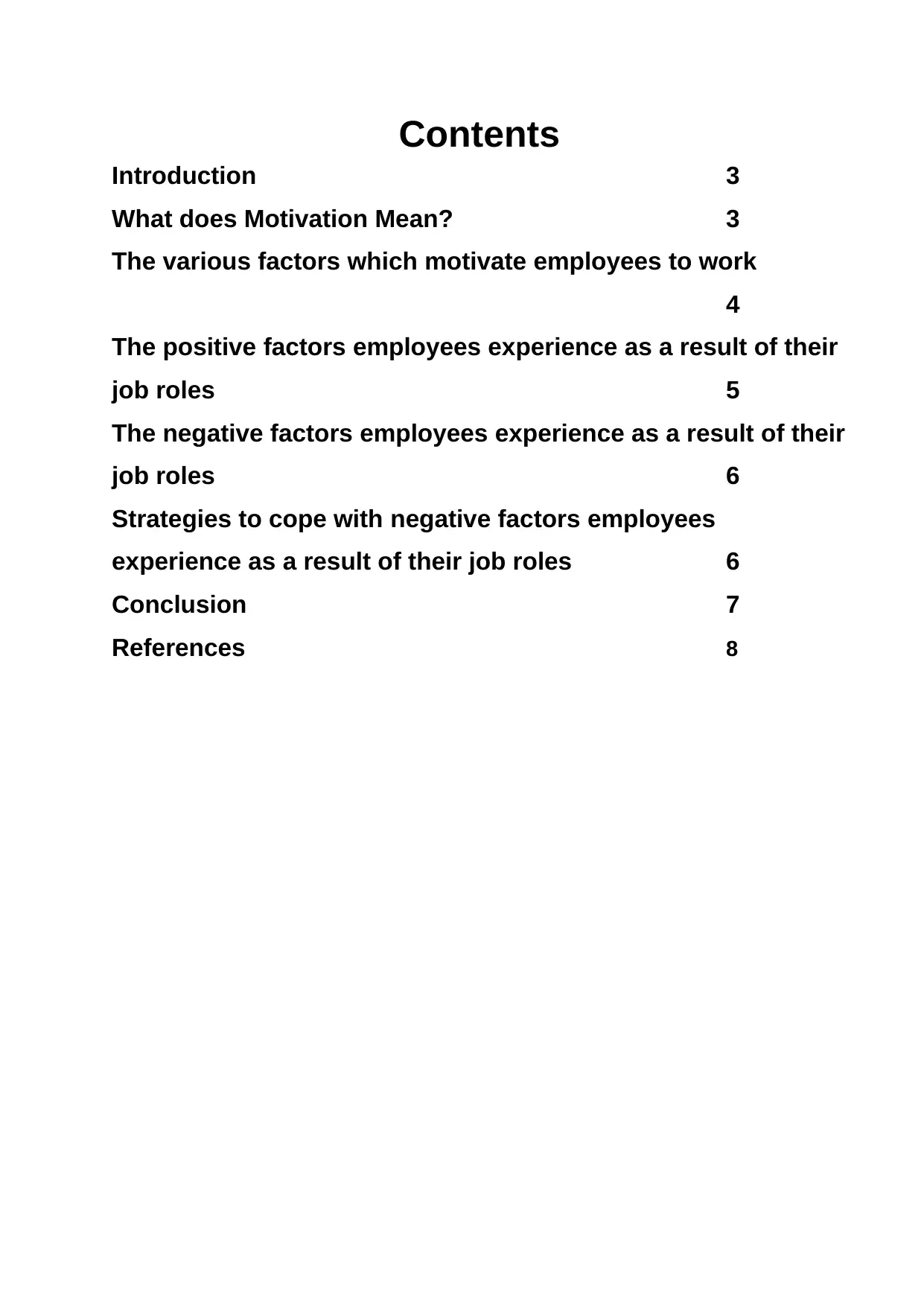
Contents
Introduction 3
What does Motivation Mean? 3
The various factors which motivate employees to work
4
The positive factors employees experience as a result of their
job roles 5
The negative factors employees experience as a result of their
job roles 6
Strategies to cope with negative factors employees
experience as a result of their job roles 6
Conclusion 7
References 8
Introduction 3
What does Motivation Mean? 3
The various factors which motivate employees to work
4
The positive factors employees experience as a result of their
job roles 5
The negative factors employees experience as a result of their
job roles 6
Strategies to cope with negative factors employees
experience as a result of their job roles 6
Conclusion 7
References 8
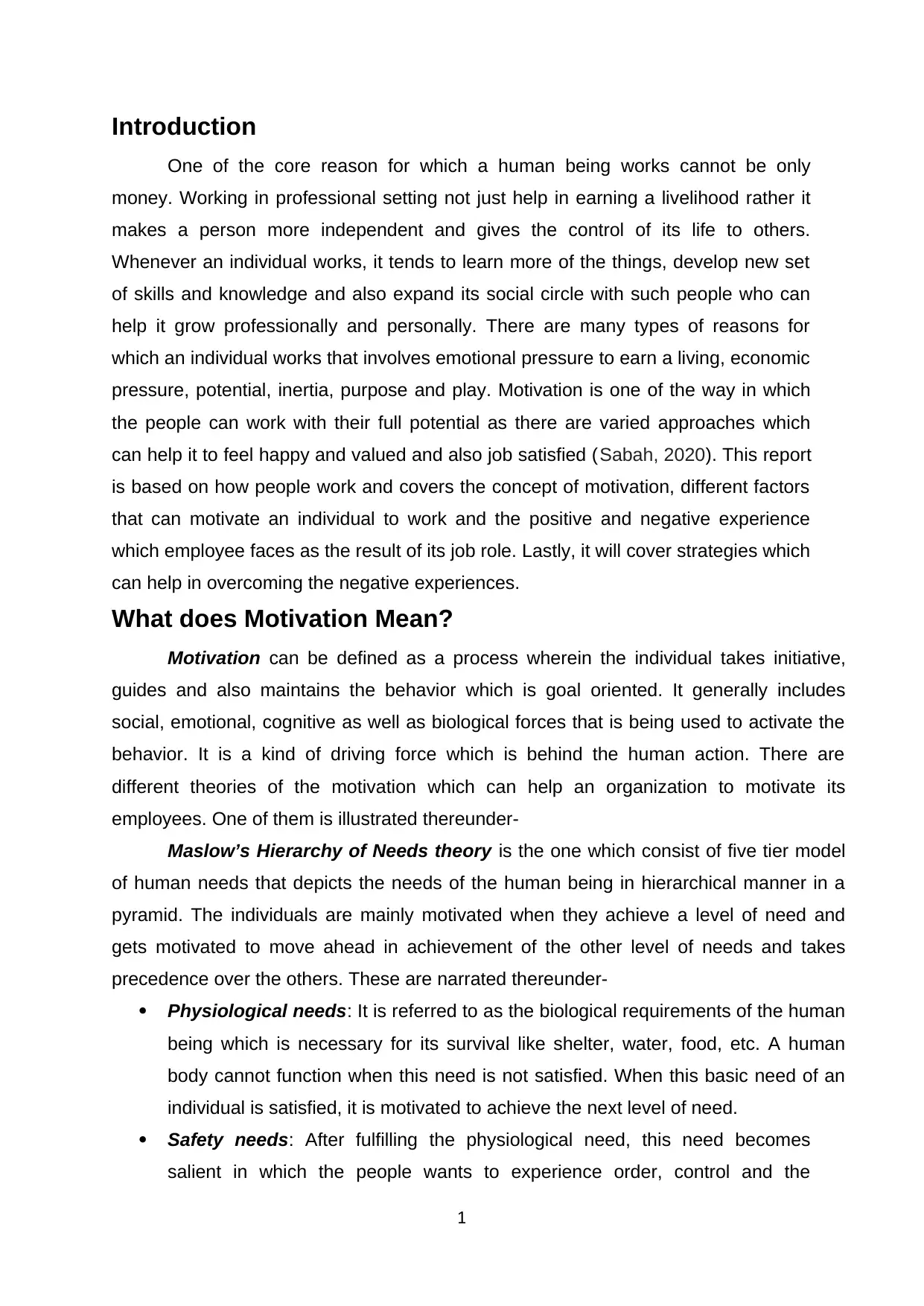
Introduction
One of the core reason for which a human being works cannot be only
money. Working in professional setting not just help in earning a livelihood rather it
makes a person more independent and gives the control of its life to others.
Whenever an individual works, it tends to learn more of the things, develop new set
of skills and knowledge and also expand its social circle with such people who can
help it grow professionally and personally. There are many types of reasons for
which an individual works that involves emotional pressure to earn a living, economic
pressure, potential, inertia, purpose and play. Motivation is one of the way in which
the people can work with their full potential as there are varied approaches which
can help it to feel happy and valued and also job satisfied (Sabah, 2020). This report
is based on how people work and covers the concept of motivation, different factors
that can motivate an individual to work and the positive and negative experience
which employee faces as the result of its job role. Lastly, it will cover strategies which
can help in overcoming the negative experiences.
What does Motivation Mean?
Motivation can be defined as a process wherein the individual takes initiative,
guides and also maintains the behavior which is goal oriented. It generally includes
social, emotional, cognitive as well as biological forces that is being used to activate the
behavior. It is a kind of driving force which is behind the human action. There are
different theories of the motivation which can help an organization to motivate its
employees. One of them is illustrated thereunder-
Maslow’s Hierarchy of Needs theory is the one which consist of five tier model
of human needs that depicts the needs of the human being in hierarchical manner in a
pyramid. The individuals are mainly motivated when they achieve a level of need and
gets motivated to move ahead in achievement of the other level of needs and takes
precedence over the others. These are narrated thereunder-
Physiological needs: It is referred to as the biological requirements of the human
being which is necessary for its survival like shelter, water, food, etc. A human
body cannot function when this need is not satisfied. When this basic need of an
individual is satisfied, it is motivated to achieve the next level of need.
Safety needs: After fulfilling the physiological need, this need becomes
salient in which the people wants to experience order, control and the
1
One of the core reason for which a human being works cannot be only
money. Working in professional setting not just help in earning a livelihood rather it
makes a person more independent and gives the control of its life to others.
Whenever an individual works, it tends to learn more of the things, develop new set
of skills and knowledge and also expand its social circle with such people who can
help it grow professionally and personally. There are many types of reasons for
which an individual works that involves emotional pressure to earn a living, economic
pressure, potential, inertia, purpose and play. Motivation is one of the way in which
the people can work with their full potential as there are varied approaches which
can help it to feel happy and valued and also job satisfied (Sabah, 2020). This report
is based on how people work and covers the concept of motivation, different factors
that can motivate an individual to work and the positive and negative experience
which employee faces as the result of its job role. Lastly, it will cover strategies which
can help in overcoming the negative experiences.
What does Motivation Mean?
Motivation can be defined as a process wherein the individual takes initiative,
guides and also maintains the behavior which is goal oriented. It generally includes
social, emotional, cognitive as well as biological forces that is being used to activate the
behavior. It is a kind of driving force which is behind the human action. There are
different theories of the motivation which can help an organization to motivate its
employees. One of them is illustrated thereunder-
Maslow’s Hierarchy of Needs theory is the one which consist of five tier model
of human needs that depicts the needs of the human being in hierarchical manner in a
pyramid. The individuals are mainly motivated when they achieve a level of need and
gets motivated to move ahead in achievement of the other level of needs and takes
precedence over the others. These are narrated thereunder-
Physiological needs: It is referred to as the biological requirements of the human
being which is necessary for its survival like shelter, water, food, etc. A human
body cannot function when this need is not satisfied. When this basic need of an
individual is satisfied, it is motivated to achieve the next level of need.
Safety needs: After fulfilling the physiological need, this need becomes
salient in which the people wants to experience order, control and the
1
⊘ This is a preview!⊘
Do you want full access?
Subscribe today to unlock all pages.

Trusted by 1+ million students worldwide
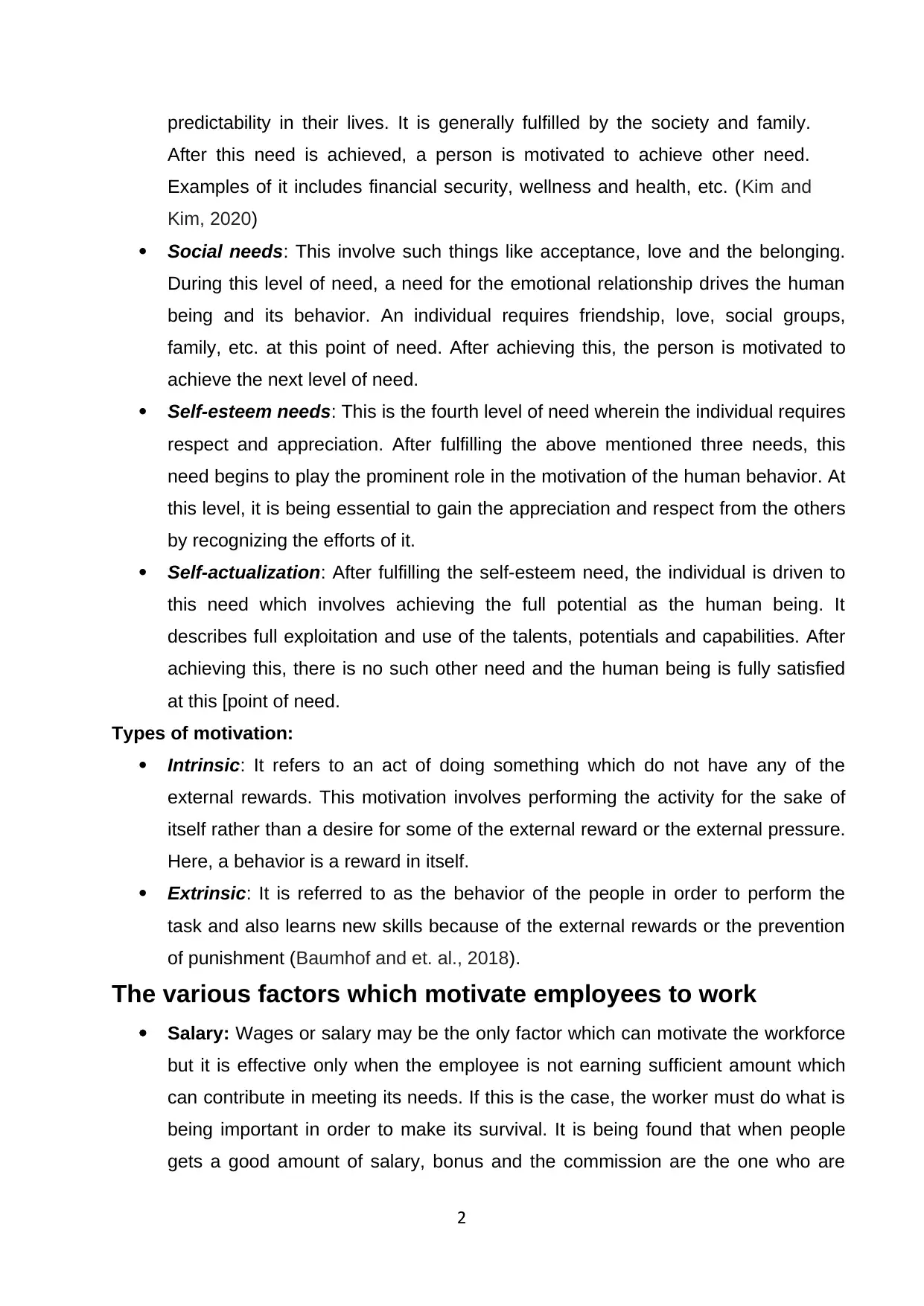
predictability in their lives. It is generally fulfilled by the society and family.
After this need is achieved, a person is motivated to achieve other need.
Examples of it includes financial security, wellness and health, etc. (Kim and
Kim, 2020)
Social needs: This involve such things like acceptance, love and the belonging.
During this level of need, a need for the emotional relationship drives the human
being and its behavior. An individual requires friendship, love, social groups,
family, etc. at this point of need. After achieving this, the person is motivated to
achieve the next level of need.
Self-esteem needs: This is the fourth level of need wherein the individual requires
respect and appreciation. After fulfilling the above mentioned three needs, this
need begins to play the prominent role in the motivation of the human behavior. At
this level, it is being essential to gain the appreciation and respect from the others
by recognizing the efforts of it.
Self-actualization: After fulfilling the self-esteem need, the individual is driven to
this need which involves achieving the full potential as the human being. It
describes full exploitation and use of the talents, potentials and capabilities. After
achieving this, there is no such other need and the human being is fully satisfied
at this [point of need.
Types of motivation:
Intrinsic: It refers to an act of doing something which do not have any of the
external rewards. This motivation involves performing the activity for the sake of
itself rather than a desire for some of the external reward or the external pressure.
Here, a behavior is a reward in itself.
Extrinsic: It is referred to as the behavior of the people in order to perform the
task and also learns new skills because of the external rewards or the prevention
of punishment (Baumhof and et. al., 2018).
The various factors which motivate employees to work
Salary: Wages or salary may be the only factor which can motivate the workforce
but it is effective only when the employee is not earning sufficient amount which
can contribute in meeting its needs. If this is the case, the worker must do what is
being important in order to make its survival. It is being found that when people
gets a good amount of salary, bonus and the commission are the one who are
2
After this need is achieved, a person is motivated to achieve other need.
Examples of it includes financial security, wellness and health, etc. (Kim and
Kim, 2020)
Social needs: This involve such things like acceptance, love and the belonging.
During this level of need, a need for the emotional relationship drives the human
being and its behavior. An individual requires friendship, love, social groups,
family, etc. at this point of need. After achieving this, the person is motivated to
achieve the next level of need.
Self-esteem needs: This is the fourth level of need wherein the individual requires
respect and appreciation. After fulfilling the above mentioned three needs, this
need begins to play the prominent role in the motivation of the human behavior. At
this level, it is being essential to gain the appreciation and respect from the others
by recognizing the efforts of it.
Self-actualization: After fulfilling the self-esteem need, the individual is driven to
this need which involves achieving the full potential as the human being. It
describes full exploitation and use of the talents, potentials and capabilities. After
achieving this, there is no such other need and the human being is fully satisfied
at this [point of need.
Types of motivation:
Intrinsic: It refers to an act of doing something which do not have any of the
external rewards. This motivation involves performing the activity for the sake of
itself rather than a desire for some of the external reward or the external pressure.
Here, a behavior is a reward in itself.
Extrinsic: It is referred to as the behavior of the people in order to perform the
task and also learns new skills because of the external rewards or the prevention
of punishment (Baumhof and et. al., 2018).
The various factors which motivate employees to work
Salary: Wages or salary may be the only factor which can motivate the workforce
but it is effective only when the employee is not earning sufficient amount which
can contribute in meeting its needs. If this is the case, the worker must do what is
being important in order to make its survival. It is being found that when people
gets a good amount of salary, bonus and the commission are the one who are
2
Paraphrase This Document
Need a fresh take? Get an instant paraphrase of this document with our AI Paraphraser
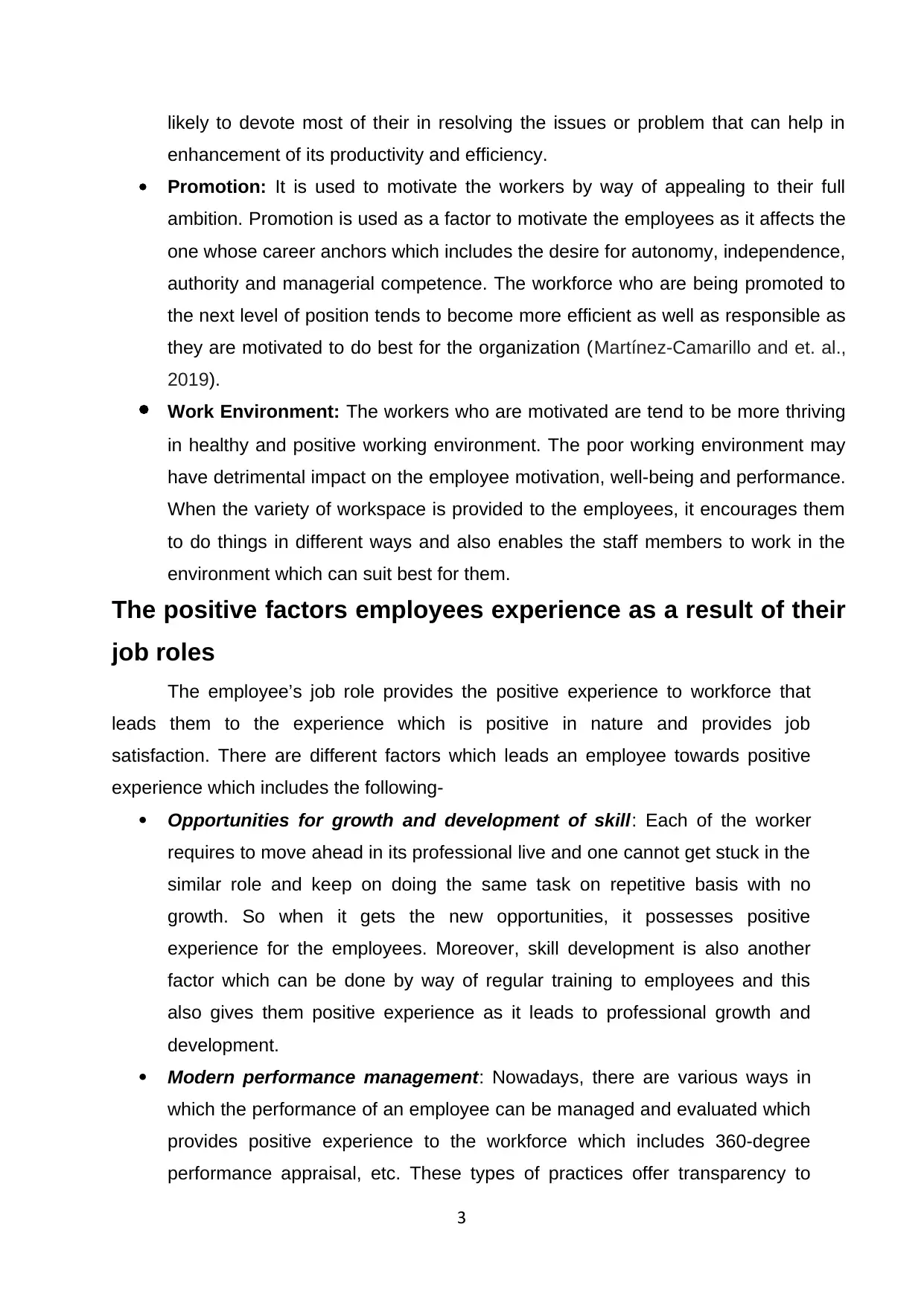
likely to devote most of their in resolving the issues or problem that can help in
enhancement of its productivity and efficiency.
Promotion: It is used to motivate the workers by way of appealing to their full
ambition. Promotion is used as a factor to motivate the employees as it affects the
one whose career anchors which includes the desire for autonomy, independence,
authority and managerial competence. The workforce who are being promoted to
the next level of position tends to become more efficient as well as responsible as
they are motivated to do best for the organization (Martínez-Camarillo and et. al.,
2019).
Work Environment: The workers who are motivated are tend to be more thriving
in healthy and positive working environment. The poor working environment may
have detrimental impact on the employee motivation, well-being and performance.
When the variety of workspace is provided to the employees, it encourages them
to do things in different ways and also enables the staff members to work in the
environment which can suit best for them.
The positive factors employees experience as a result of their
job roles
The employee’s job role provides the positive experience to workforce that
leads them to the experience which is positive in nature and provides job
satisfaction. There are different factors which leads an employee towards positive
experience which includes the following-
Opportunities for growth and development of skill: Each of the worker
requires to move ahead in its professional live and one cannot get stuck in the
similar role and keep on doing the same task on repetitive basis with no
growth. So when it gets the new opportunities, it possesses positive
experience for the employees. Moreover, skill development is also another
factor which can be done by way of regular training to employees and this
also gives them positive experience as it leads to professional growth and
development.
Modern performance management: Nowadays, there are various ways in
which the performance of an employee can be managed and evaluated which
provides positive experience to the workforce which includes 360-degree
performance appraisal, etc. These types of practices offer transparency to
3
enhancement of its productivity and efficiency.
Promotion: It is used to motivate the workers by way of appealing to their full
ambition. Promotion is used as a factor to motivate the employees as it affects the
one whose career anchors which includes the desire for autonomy, independence,
authority and managerial competence. The workforce who are being promoted to
the next level of position tends to become more efficient as well as responsible as
they are motivated to do best for the organization (Martínez-Camarillo and et. al.,
2019).
Work Environment: The workers who are motivated are tend to be more thriving
in healthy and positive working environment. The poor working environment may
have detrimental impact on the employee motivation, well-being and performance.
When the variety of workspace is provided to the employees, it encourages them
to do things in different ways and also enables the staff members to work in the
environment which can suit best for them.
The positive factors employees experience as a result of their
job roles
The employee’s job role provides the positive experience to workforce that
leads them to the experience which is positive in nature and provides job
satisfaction. There are different factors which leads an employee towards positive
experience which includes the following-
Opportunities for growth and development of skill: Each of the worker
requires to move ahead in its professional live and one cannot get stuck in the
similar role and keep on doing the same task on repetitive basis with no
growth. So when it gets the new opportunities, it possesses positive
experience for the employees. Moreover, skill development is also another
factor which can be done by way of regular training to employees and this
also gives them positive experience as it leads to professional growth and
development.
Modern performance management: Nowadays, there are various ways in
which the performance of an employee can be managed and evaluated which
provides positive experience to the workforce which includes 360-degree
performance appraisal, etc. These types of practices offer transparency to
3
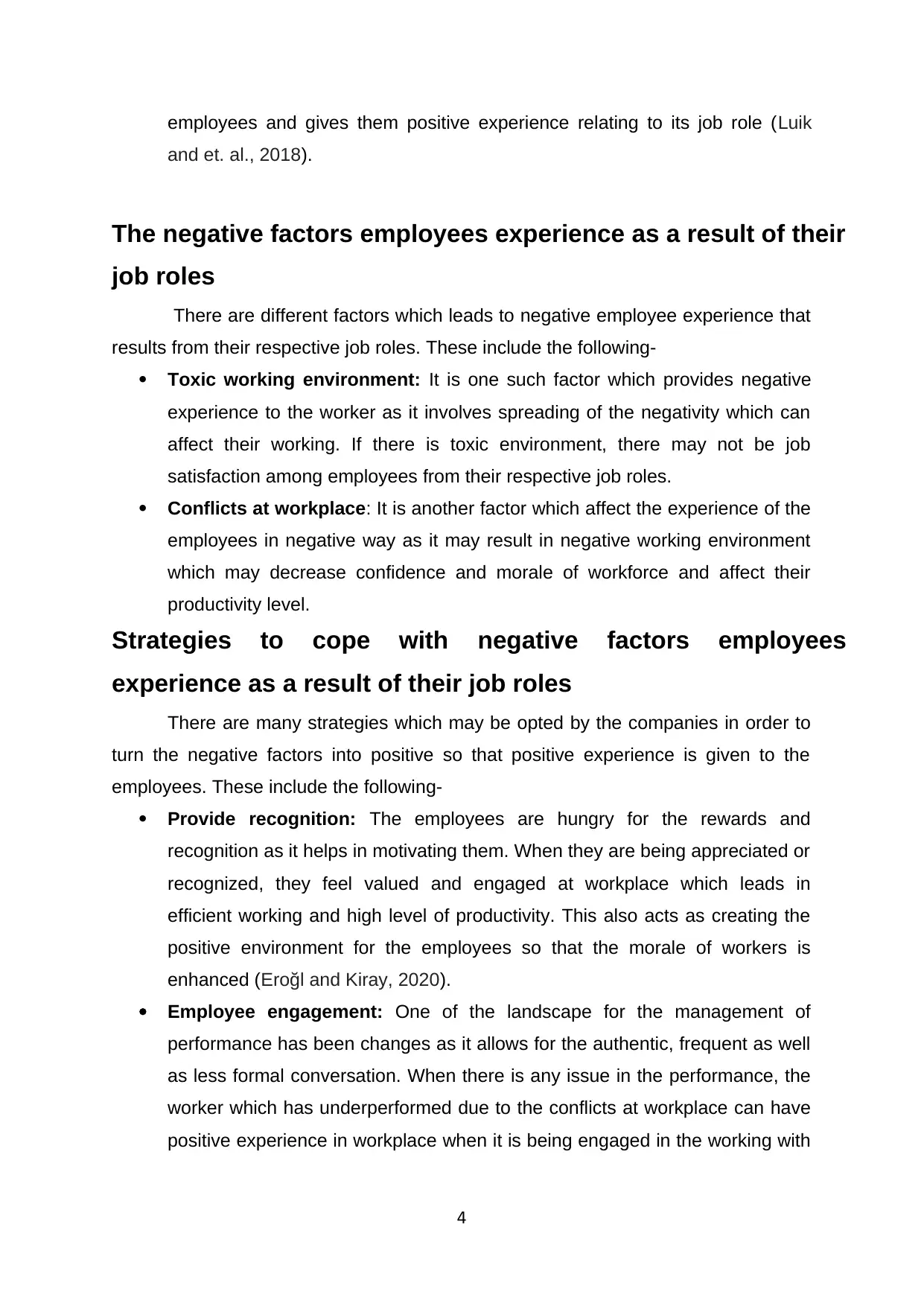
employees and gives them positive experience relating to its job role (Luik
and et. al., 2018).
The negative factors employees experience as a result of their
job roles
There are different factors which leads to negative employee experience that
results from their respective job roles. These include the following-
Toxic working environment: It is one such factor which provides negative
experience to the worker as it involves spreading of the negativity which can
affect their working. If there is toxic environment, there may not be job
satisfaction among employees from their respective job roles.
Conflicts at workplace: It is another factor which affect the experience of the
employees in negative way as it may result in negative working environment
which may decrease confidence and morale of workforce and affect their
productivity level.
Strategies to cope with negative factors employees
experience as a result of their job roles
There are many strategies which may be opted by the companies in order to
turn the negative factors into positive so that positive experience is given to the
employees. These include the following-
Provide recognition: The employees are hungry for the rewards and
recognition as it helps in motivating them. When they are being appreciated or
recognized, they feel valued and engaged at workplace which leads in
efficient working and high level of productivity. This also acts as creating the
positive environment for the employees so that the morale of workers is
enhanced (Eroğl and Kiray, 2020).
Employee engagement: One of the landscape for the management of
performance has been changes as it allows for the authentic, frequent as well
as less formal conversation. When there is any issue in the performance, the
worker which has underperformed due to the conflicts at workplace can have
positive experience in workplace when it is being engaged in the working with
4
and et. al., 2018).
The negative factors employees experience as a result of their
job roles
There are different factors which leads to negative employee experience that
results from their respective job roles. These include the following-
Toxic working environment: It is one such factor which provides negative
experience to the worker as it involves spreading of the negativity which can
affect their working. If there is toxic environment, there may not be job
satisfaction among employees from their respective job roles.
Conflicts at workplace: It is another factor which affect the experience of the
employees in negative way as it may result in negative working environment
which may decrease confidence and morale of workforce and affect their
productivity level.
Strategies to cope with negative factors employees
experience as a result of their job roles
There are many strategies which may be opted by the companies in order to
turn the negative factors into positive so that positive experience is given to the
employees. These include the following-
Provide recognition: The employees are hungry for the rewards and
recognition as it helps in motivating them. When they are being appreciated or
recognized, they feel valued and engaged at workplace which leads in
efficient working and high level of productivity. This also acts as creating the
positive environment for the employees so that the morale of workers is
enhanced (Eroğl and Kiray, 2020).
Employee engagement: One of the landscape for the management of
performance has been changes as it allows for the authentic, frequent as well
as less formal conversation. When there is any issue in the performance, the
worker which has underperformed due to the conflicts at workplace can have
positive experience in workplace when it is being engaged in the working with
4
⊘ This is a preview!⊘
Do you want full access?
Subscribe today to unlock all pages.

Trusted by 1+ million students worldwide
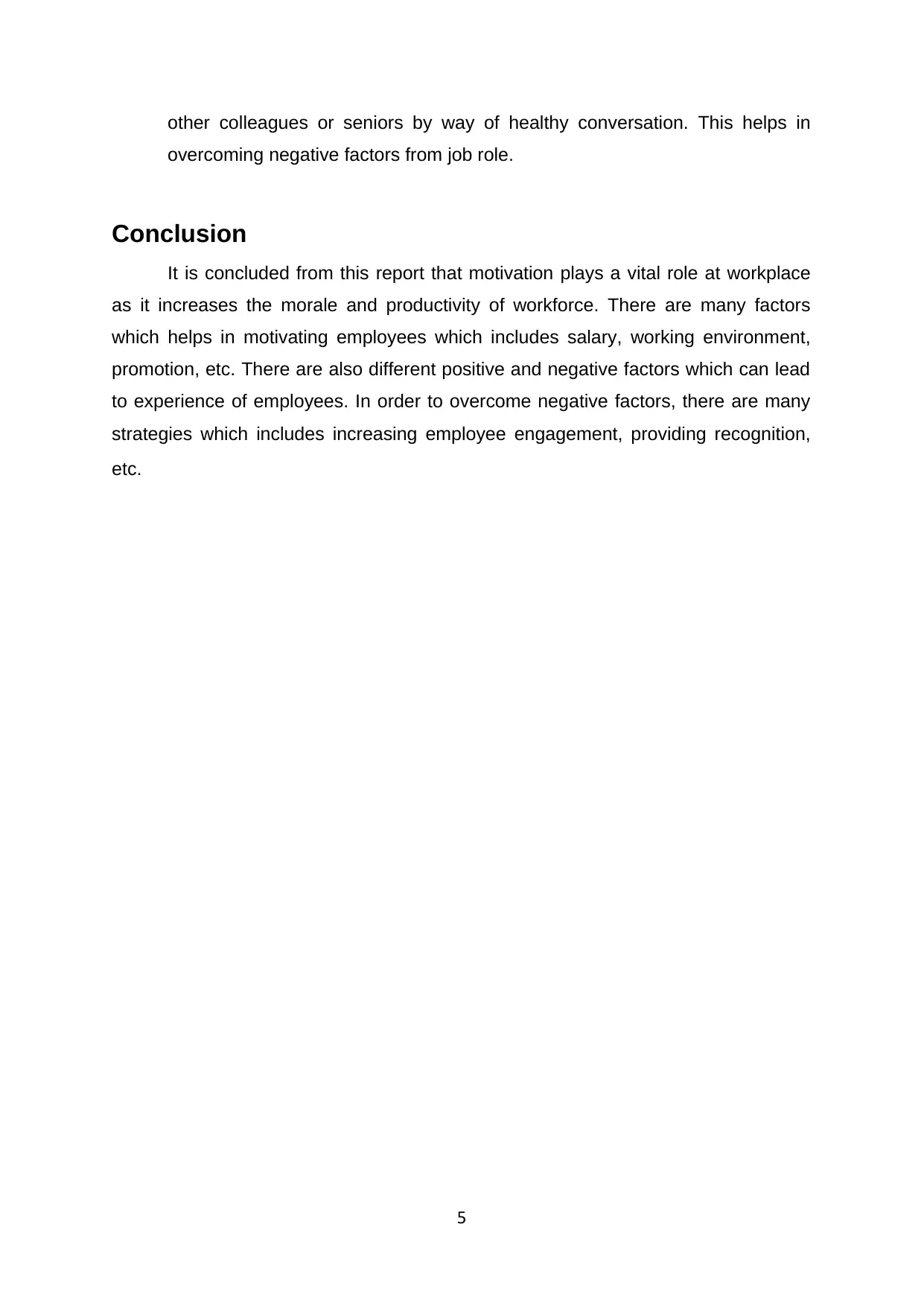
other colleagues or seniors by way of healthy conversation. This helps in
overcoming negative factors from job role.
Conclusion
It is concluded from this report that motivation plays a vital role at workplace
as it increases the morale and productivity of workforce. There are many factors
which helps in motivating employees which includes salary, working environment,
promotion, etc. There are also different positive and negative factors which can lead
to experience of employees. In order to overcome negative factors, there are many
strategies which includes increasing employee engagement, providing recognition,
etc.
5
overcoming negative factors from job role.
Conclusion
It is concluded from this report that motivation plays a vital role at workplace
as it increases the morale and productivity of workforce. There are many factors
which helps in motivating employees which includes salary, working environment,
promotion, etc. There are also different positive and negative factors which can lead
to experience of employees. In order to overcome negative factors, there are many
strategies which includes increasing employee engagement, providing recognition,
etc.
5
Paraphrase This Document
Need a fresh take? Get an instant paraphrase of this document with our AI Paraphraser
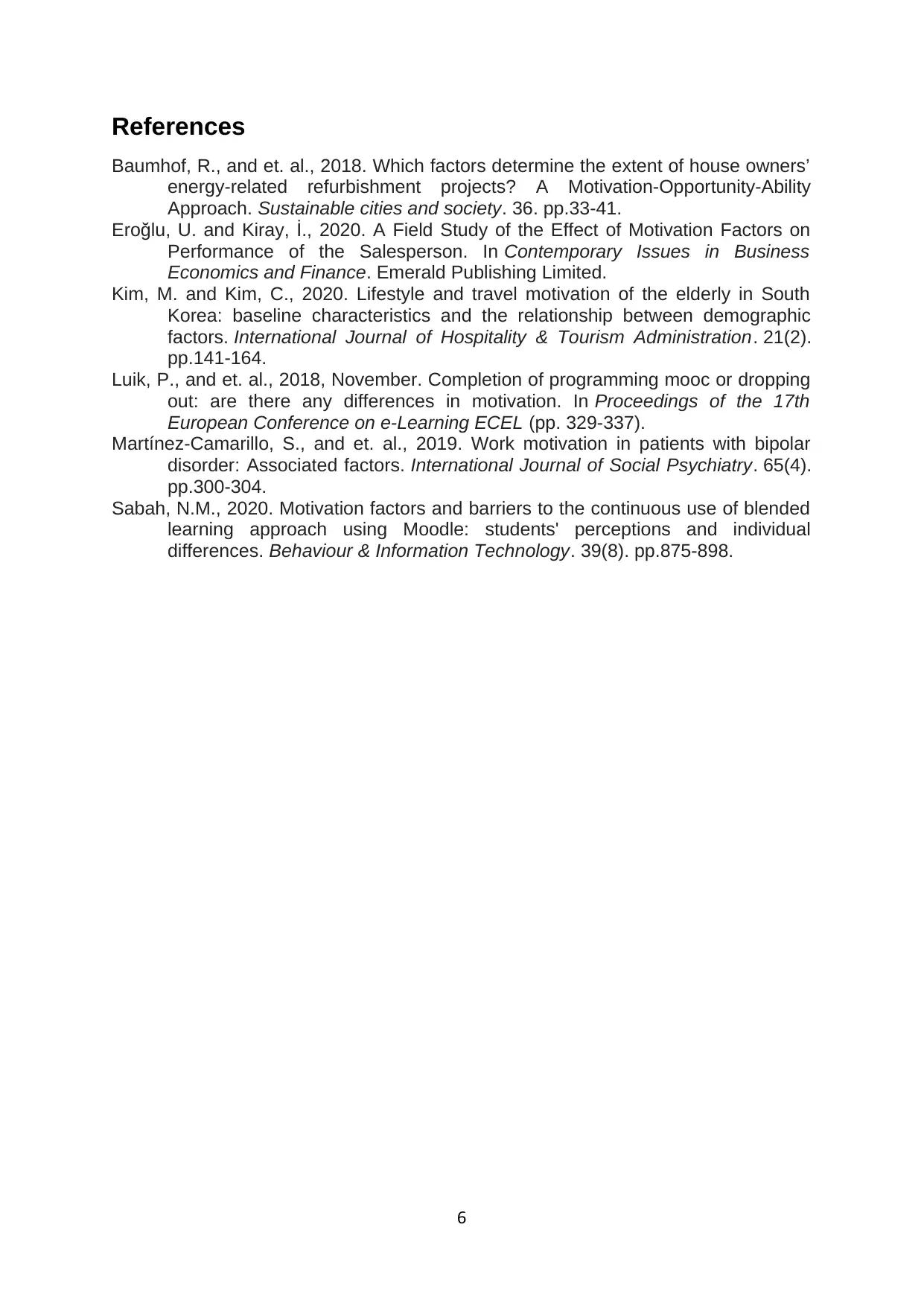
References
Baumhof, R., and et. al., 2018. Which factors determine the extent of house owners’
energy-related refurbishment projects? A Motivation-Opportunity-Ability
Approach. Sustainable cities and society. 36. pp.33-41.
Eroğlu, U. and Kiray, İ., 2020. A Field Study of the Effect of Motivation Factors on
Performance of the Salesperson. In Contemporary Issues in Business
Economics and Finance. Emerald Publishing Limited.
Kim, M. and Kim, C., 2020. Lifestyle and travel motivation of the elderly in South
Korea: baseline characteristics and the relationship between demographic
factors. International Journal of Hospitality & Tourism Administration. 21(2).
pp.141-164.
Luik, P., and et. al., 2018, November. Completion of programming mooc or dropping
out: are there any differences in motivation. In Proceedings of the 17th
European Conference on e-Learning ECEL (pp. 329-337).
Martínez-Camarillo, S., and et. al., 2019. Work motivation in patients with bipolar
disorder: Associated factors. International Journal of Social Psychiatry. 65(4).
pp.300-304.
Sabah, N.M., 2020. Motivation factors and barriers to the continuous use of blended
learning approach using Moodle: students' perceptions and individual
differences. Behaviour & Information Technology. 39(8). pp.875-898.
6
Baumhof, R., and et. al., 2018. Which factors determine the extent of house owners’
energy-related refurbishment projects? A Motivation-Opportunity-Ability
Approach. Sustainable cities and society. 36. pp.33-41.
Eroğlu, U. and Kiray, İ., 2020. A Field Study of the Effect of Motivation Factors on
Performance of the Salesperson. In Contemporary Issues in Business
Economics and Finance. Emerald Publishing Limited.
Kim, M. and Kim, C., 2020. Lifestyle and travel motivation of the elderly in South
Korea: baseline characteristics and the relationship between demographic
factors. International Journal of Hospitality & Tourism Administration. 21(2).
pp.141-164.
Luik, P., and et. al., 2018, November. Completion of programming mooc or dropping
out: are there any differences in motivation. In Proceedings of the 17th
European Conference on e-Learning ECEL (pp. 329-337).
Martínez-Camarillo, S., and et. al., 2019. Work motivation in patients with bipolar
disorder: Associated factors. International Journal of Social Psychiatry. 65(4).
pp.300-304.
Sabah, N.M., 2020. Motivation factors and barriers to the continuous use of blended
learning approach using Moodle: students' perceptions and individual
differences. Behaviour & Information Technology. 39(8). pp.875-898.
6
1 out of 8
Related Documents
Your All-in-One AI-Powered Toolkit for Academic Success.
+13062052269
info@desklib.com
Available 24*7 on WhatsApp / Email
![[object Object]](/_next/static/media/star-bottom.7253800d.svg)
Unlock your academic potential
Copyright © 2020–2025 A2Z Services. All Rights Reserved. Developed and managed by ZUCOL.



